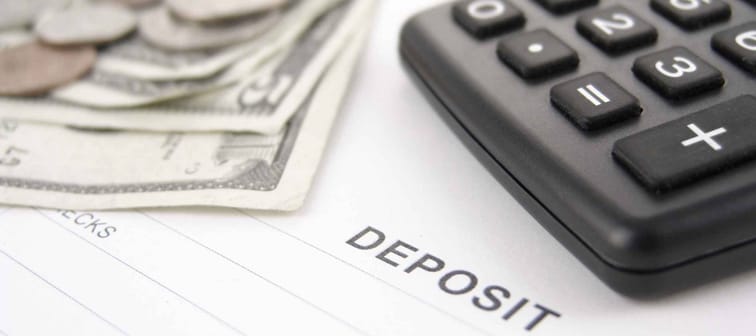Checking accounts vs. savings accounts
The two basic accounts most people need are a checking account and a savings account. Although they may look similar at first glance, the accounts help with your finances in different ways.
Ready to secure and grow your money? Here's how to get the most out of checking and savings accounts.
Ready to boost your savings?
Click here for the best savings accounts! Discover top rates and no-fee options to grow your money effortlessly.
Start saving smarter today!What is a checking account?
A checking account is meant for day-to-day transactions: Paychecks and other deposits go in, and bill payments and spending money go out.
Advantages
When you open a checking account, you receive a debit card that makes it easy to withdraw cash at ATMs and make purchases directly from your account.
Checking accounts also allow users to quickly set up online and automatic bill payments. And yes, you can still write paper checks from your account — which, after all, is how checking accounts got their name.
Disadvantages
Most checking accounts offer little or no interest on your money, so they're most ideal for spending or withdrawing money frequently.
You won't want to save money in a checking account — in other words, you shouldn't let it sit there long term. There's a better option for that.
What is a savings account?
A savings account is a bank account that lets you store money you don't plan to spend immediately. But savings accounts do allow quick access to your money, when you need to dip into it.
Advantages
Savings accounts are designed for parking money for a time and letting it earn some interest — which makes them ideal accounts for building an emergency fund or for saving money for short-term financial goals.
You have many ways to transfer money out of your savings: You can do it at a bank branch, an ATM, via electronic transfer, by direct deposit, or by using your bank's smartphone app or website.
Disadvantages
Savings accounts come with withdrawal and transfer limits. While most savings accounts don't cap how much money you can take out or send to another account at one time, they typically limit transactions to no more than six per month.
Subscribe to our newsletter.
Join our community of 200,000+ financially savvy subscribers who receive top stories and exclusive offers.
SubscribeDifferences between checking and savings accounts
Here's a quick look at how checking and savings accounts are different.
| Checking Account | Savings Account | |
|---|---|---|
| Minimum balance requirements | Vary by financial institution. | Vary by financial institution. |
| Withdrawal restrictions | Vary by financial institution. | Typically no more than six withdrawals or transfers per month. |
| Monthly fees | Sometimes. Fees vary by financial institution. | Sometimes. Fees vary by financial institution. |
| Interest | Minimal to none. | Some. Varies by financial institution. |
| Access | Any time. | Any time. But use can be limited, and you can be charged a fee if you exceed the restrictions. |
| Other features | Online access, overdraft protection, automatic bill paying. | Online access, automatic savings from your paycheck. |
One major difference between the two types of accounts is how often you can use them.
Checking accounts are intended for frequent, even daily use, so the bank allows you to withdraw, spend and transfer money many times a month. Make sure to ask your bank how many transactions are allowed before any fee kicks in.
By contrast, savings accounts are intended for you to leave your money in the bank and let it grow, so you're allowed only a few transactions per month.
This is based on Federal Reserve Board Regulation D, a law that says users can make only six withdrawals or transfers out of their savings accounts each month.
Another difference is that the average interest rate on checking accounts is very low — around 0.06%, according to the FDIC — while savings accounts pay slightly more, hovering around 0.09%, on average.
While that may not sound like much either, you can find high-yield savings accounts with interest rates approaching 2%.
Either a checking or a savings account will offer you easy access to your money — and keep it safe.
Which account is right for you?
You don't need to make a choice between a checking or a savings account, because most people have both. While it all comes down to how you want to manage your money, it’s best to have both accounts for optimal spending and saving.
When looking for a new checking or savings account, pay attention to all of the features, including fees and minimum balance requirements. Different banks will handle these features differently, so it's smart to shop around and consider all your options.
You don’t want to end up with a bank account that isn’t ideal, just because you rushed into a decision.
Fees
While it's possible to find a free checking account, you'll have to do at least a little bit of research to find one.
Most banks charge fees as a way for you to pay for using their services. Fees include overdraft charges, fees if you fail to maintain a certain minimum balance, and monthly account maintenance costs. The nation's largest banks charge monthly fees averaging $9.60 for a basic checking account, according to MyBankTracker.
Having a checking or savings account can wind up being costly, but here are a few tips to help you save some money:
- Talk to your bank to see if you can get certain fees waived, like the minimum balance charge. If you can’t avoid it, sign up for direct deposit so you won’t miss depositing a check on time.
- Try to use your own bank as much as possible. ATM usage fees and foreign transaction fees can hit you when you’re outside your home area or out of the country, and have to use your card at a different bank or ATM.
- While fees for cashier’s checks and money orders are sometimes unavoidable, you can save money by minimizing the amount of times you need these types of bank services. Some banks will let you skip these fees if you open a premium account or have multiple accounts at the financial institution.
Interest
When you think of interest, you probably think about having to pay the bank extra money, like when you take out a mortgage or a car loan. True, interest is a cost of borrowing, but it's also a payment you receive for allowing a bank to hold your money.
As stated earlier, savings accounts pay interest. Checking accounts can, too — but their returns are usually pretty puny.
When choosing a savings account, explore the different types that a bank offers. To get the most out of your savings, look into a high-yield, or high-interest, account, which will offer much better interest than a standard savings account. These accounts work well when you have a short-term savings goal, such as for a vacation.
Comparison shop to find the best savings account. And keep in mind that the high rates touted by some banks may be promotional and not as good as the everyday interest offered by online banks, which have lower costs that they can pass along to their customers.
You may find you need to venture beyond your regular bank for a good high-interest savings account. But don't worry, because transferring money between banks is easy.
When it comes to checking, you might discover that some checking accounts offer higher interest than others, but often a higher interest rate on checking is capped up to a certain balance. Every dollar over the cap will earn a much lower rate.
Ease of use
One main draw of checking accounts is their ease of transactions. You can use your debit card, pay with checks, or make the electronic transactions known as ACH withdrawals. But note that — for security reasons — banks limit the numbers of ATM withdrawals and debit card transactions you can make from your checking account each day.
Savings accounts typically curb the number of transactions per month. Federal regulations often limit withdrawals and transfers to six per month, under certain circumstances. If you exceed those regulations, you may be charged a fee, or the bank may switch your savings account into a low-to-no-interest checking account.
Generally, checking or savings accounts are easier to use if you:
- Take advantage of online banking.
- Link two account together for easy transfers.
- Use the bank's mobile app.
- Make mobile deposits using your smartphone.
- Sign up for alerts that will tell you whenever a large deposit or withdrawal has been made to your account, or let you know if you're close to getting hit with a fee, maybe for a low balance.
Remember: No matter what account you open, be sure that it's with an FDIC-insured institution.
"Being FDIC insured means that the United States government protects you against the loss of your insured deposits if an FDIC-insured bank or savings associate fails," the agency explains.
In the unlikely event that your bank fails to keep your money safe, the FDIC will reimburse your losses up to $250,000.
The richest 1% use an advisor. Do you?
Wealthy people know that having money is not the same as being good with money. Advisor.com can help you shape your financial future and connect with expert guidance . A trusted advisor helps you make smart choices about investments, retirement savings, and tax planning.
Try it now









